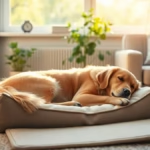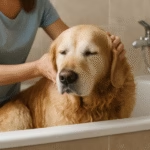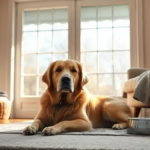Why Positive Reinforcement Works Best in Behavior Training
I explain how reward-based methods help my senior Golden learn without fear. I keep sessions short, gentle, and low-impact to protect my dog’s joints. I use clicker cues and tasty treats to cut stress and boost learning. Below I share a simple daily plan, a safety checklist, and the gentle steps I follow with patience and care.
Key Takeaway
- I use gentle praise and treats to help my senior Golden feel safe.
- I reward small steps so my dog stays calm and tries again.
- I move at my dog’s pace and avoid force or rush.
- I celebrate little wins to keep my dog happy and confident.
- I check with my vet so rewards match my dog’s health needs — and I adapt training if pain or mobility issues arise (signs of pain).
Why Positive Reinforcement Works Best in Behavior Training for My Senior Golden
Why Positive Reinforcement Works Best in Behavior Training is simple for me: older dogs learn by feel and memory, not by fear. My senior Golden has aches, slower reflexes, and fading hearing, so I trade loud corrections for small wins. When I reward a good choice, she repeats it because the moment links action to a pleasant result. That link is quick and clear for her mind.
Short, frequent sessions fit her energy and mood. I use treats, soft praise, and gentle pets right after the desired behavior. Those small rewards light up her face and make training feel like play. Over time, the good behaviors become habits she chooses even on stiff-joint days.
Positive reinforcement also keeps our bond strong — it’s the same gentle approach I use to deepen connection and trust with age-appropriate methods (building stronger bonds). I don’t want training to feel like a test she might fail. When I reward calm behavior, she trusts me more and shows fewer anxious signs. That trust makes learning faster and life kinder for both of us.
How positive reinforcement benefits for senior dogs are backed by learning science
Learning science shows animals learn from consequences: when a behavior leads to something pleasant, it happens more often. For senior dogs, this principle is clearer because stress and pain can shut down learning if training is harsh. I follow simple science-backed steps: reward right after the action, keep sessions short, and repeat kindly.
Older dogs form habits through repetition and reward. Their brains may slow, but reward pathways still work. Tiny, tasty treats trigger quick brain responses and create memory links that outlast moments of confusion. In my experience, this helps memories stick far better than scolding.
| Reward Type | Best Use | Example |
|---|---|---|
| Soft Treats | Short focus work, low energy | Small chicken bites during sit/wait |
| Praise/Voice | When mobility or food is limited | Gentle good girl and ear rub |
| Toy/Play | To build joy and recall | Short tug after a successful recall |
| Touch/Comfort | For anxious moments | Slow petting after calm behavior |
For ideas to keep your older dog’s mind engaged while using these rewards, I often borrow activities from my go-to list of mental games (keeping the mind active) and simple enrichment plans (mental enrichment activities).
How I reduce stress and boost learning with reward-based training for senior Goldens
I start each session by reading my dog’s mood. If she seems stiff or distracted, I choose the gentlest rewards and cut the session to a minute or two. Success breeds calm, and calm breeds more success.
I break tasks into tiny steps and praise every small win. If I want her to go to her bed, I first reward looking at the bed, then stepping closer, then stepping on it. This shaping avoids pushing her beyond comfort and keeps learning positive. Over weeks, the tiny wins add up into steady, confident behavior.
If separation or visitor stress is an issue, I combine gentle shaping with strategies used for older-dog anxiety (managing separation anxiety) and calm-environment setup (creating calm environments).
A simple reward plan I use every day
I stick to a short, clear routine that fits her energy and health: reward immediately, keep sessions under five minutes, and stop while she’s still eager. Consistency is my friend.
- Check mood and mobility.
- Set one clear goal (sit, settle, come).
- Use a high-value reward right after the behavior.
- End on a success and a short walk or cuddle.
- Repeat 2–3 times a day in tiny bursts.
For daily structure and gentle habit-building, I follow a healthy routine plan that matches her age and energy (creating a healthy routine).
I Use Low-Impact Training Techniques for Senior Goldens to Protect Their Joints
I’ve watched my Golden slow down and feel the tug in my chest when she hesitates to jump into the car. That’s why I switched to low-impact training: moves that keep joints safe and keep confidence high. Short sessions, slow motions, and lots of breaks are my rule.
I pay attention to posture and body language. When I ask for a sit or a paw, I make sure she isn’t twisting or straining. Small changes like training on a soft mat or using a ramp instead of a jump make a big difference — adaptions I learned from guides on how to adapt your home and manage mobility (adapting the home, mobility solutions).
I use praise and treats more than force. I want her to enjoy learning, not tense up. Gentle cues build trust and keep her willing to try new things even as she ages.
Clicker training for elderly Golden Retrievers offers precise, gentle cues
Clicker training gives a clean, quick signal that marks the exact moment she did the right thing. That clarity helps her learn without long corrections or pulling on a leash. I pair the click with soft body cues and very small movements so I avoid gestures that might twist her hips or shoulders. Over time she knows what the click means and responds with calm, careful motions. For step-by-step gentle methods, I follow age-appropriate approaches specifically for senior Goldens (gentle senior training methods).
Treat-based reinforcement lets me avoid forceful moves
Treats are my secret weapon for gentle training. I use small, soft treats so she doesn’t crunch or choke. Tiny rewards mean many repetitions without tiring her out or adding too many calories. I reward effort more than perfection: if she offers a movement that looks close, I mark it and treat. That way she learns without strain.
| Method | Why it’s gentle |
|---|---|
| Clicker | Marks exact moment; reduces need for physical correction |
| Treats | Small, soft rewards encourage many low-impact repetitions |
For low-impact exercise ideas that pair well with reward training, I consult resources on safe activity and therapeutic options (low-impact exercises, canine physical therapy, hydrotherapy).
A step-by-step low-impact session I follow
I keep a simple routine so my Golden feels safe and we both know what to expect.
- Warm up with a short walk and gentle massage for 2–3 minutes.
- Do one clear cue with the click or verbal marker and reward immediately.
- Repeat the cue 3–5 times, using very small movements from me.
- Pause and offer petting or a sniff break for 30–60 seconds.
- End the block with a favorite treat and a calm walk to cool down.
Therapeutic massage and short warm-ups are part of my prep — basic techniques I learned from simple massage guides (therapeutic massage basics).
Motivation Strategies I Rely On for Elderly Golden Retrievers
I treat motivation like a gentle nudge, not a shove. Older Goldens may move slower, hear less, or have aches. I watch their eyes and tail more than I count reps. Small wins matter because stamina and focus drop with age.
I keep a simple rule in my head: Why Positive Reinforcement Works Best in Behavior Training — reward what my dog can do today, not what she did at three years old. I use praise, touch, and tiny tasty bits to build habits without stress.
I mix motivators: sometimes a soft bite of chicken beats a commercial treat; other times a brisk five-minute walk or a belly rub lights up her face. I change pace, keep tone light, and read body language so training stays safe and kind.
I choose the best rewards with treat-based reinforcement for older Goldens
I pick treats that are soft and easy to chew, slice them into pea-sized pieces, or use mashed food. Low-calorie options help keep weight steady. I test new treats in tiny amounts and watch digestion. If food is off the table, I lean on praise, petting, or short walks as rewards.
When appetite or health is a concern, I coordinate with my vet to choose safe options and avoid triggering medical issues (watching for pain, comfort for arthritis).
I keep sessions short and fun with reward-based training for senior Goldens
I run one- to three-minute sessions several times a day. That fits their attention span and avoids fatigue. I stop while my dog is still interested; ending on a high note keeps them eager next time. If stiffness or pain shows up, I back off and check with the vet.
My checklist for safe motivation and rewards
- Check with the vet about diet and pain before changing routines.
- Choose soft, low-cal treats and cut them tiny.
- Watch calories to avoid weight gain.
- Use non-food rewards when needed: petting, sniff breaks, short walks.
- Keep sessions short and frequent.
- Stop training if the dog shows pain or stress signals.
- Track treats and make notes on what truly motivates your dog.
For treat ideas and appropriate toys that suit older mouths and curiosity, I reference lists of suitable items and enrichment toys (appropriate toys, essential equipment and supplies).
| Treat Type | When to Use | Quick Notes |
|---|---|---|
| Soft meat or pureed baby food | High-value moments or for dogs with poor teeth | Strong scent; very motivating |
| Small kibble pieces | Everyday practice | Low-cal; counts toward meal calories |
| Freeze-dried single-ingredient | Nose work or high-value rewards | Lightweight, very tasty |
| Non-food rewards (petting, walk) | When food isn’t appropriate | Great for bonding and low-calorie |
Behavior Modification Steps I Use for Senior Goldens
I start by watching my Golden closely for a few days to learn triggers and movement patterns. That gives me a clear starting point. From there I make small changes to the routine so the dog feels safe—soft lighting, quiet corners, and easy access to water and a bed.
I break every change into tiny steps. Big jumps frighten older dogs, so I move in inches, not miles. If the goal is less barking at the door, I teach a calm alternative like going to a mat and reward any sign of calm. This builds a new habit slowly and keeps the dog confident. For nuisance barking specifically, I use calm replacements and reward strategies adapted from behavior guides (addressing nuisance barking).
I keep sessions very short and joyful. Five minutes a few times a day works better than long drills. I track progress with simple notes and adjust when I see stress. If a step is too hard, I back up and make it easier. That patience pays off — my Golden learns without fear, and we both stay relaxed.
Using positive reinforcement helps manage anxiety and confusion
Positive reinforcement calms anxiety by giving the dog clear signals about what I want. Instead of punishing a confused response, I mark the right behavior with a treat or praise right away. That tells my dog, “This is safe. Do this again.” Over time, the dog chooses the calm action because it leads to good things.
I use short, predictable routines to lower confusion. For example, before guests arrive I give a favorite chew and lead my dog to a mat. When they stay calm, I reward them. The simple loop—cue, calm behavior, reward—helps the dog feel in control. For broader behavioral changes and what to expect with aging, I consult resources on normal behavioral shifts (behavioral changes with age).
- Start with one clear cue (like mat).
- Reward the tiniest calm response immediately.
- Keep sessions short and repeat daily.
- Gradually raise expectations only when the dog is ready.
- Track reactions and slow down if confusion increases.
Why Positive Reinforcement Works Best in Behavior Training when changing old habits
Why Positive Reinforcement Works Best in Behavior Training is simple: rewards build desire, not fear. With older dogs, fear can freeze learning. Rewards make a behavior worth repeating. I’ve seen stubborn habits shift when I made the new option more fun than the old one.
Older dogs remember feelings more than rules. If I pair a new habit with treats, praise, and comfort, the dog links the habit to good feelings. That replaces the old habit without stress and keeps trust strong.
| Problem Behavior | Small Reward to Use | When to Reward |
|---|---|---|
| Barking at door | Soft treat, calm praise | When dog looks at the mat instead of barking |
| Restlessness at night | Short massage, cheese cube | After settling for 2–3 minutes |
| Skittish around guests | Favorite toy, gentle pet | When dog sniffs guest calmly |
When guests or unexpected sounds trigger fear responses, I also adapt training around sensory losses like hearing or vision changes (hearing loss, vision problems).
Small behavior goals I set with gentle methods
I set tiny, clear goals: go to the mat for a meal, sit quietly when the doorbell rings, walk at a steady pace on short outings. For each goal I choose one gentle cue, reward the smallest correct response, and repeat often. When progress stalls, I make the step smaller—sometimes a single calm breath—so the dog succeeds and feels proud.
Age-Appropriate Training Tips I Follow for My Golden Retriever Senior
I slow my pace and keep sessions short. Two- to five-minute bursts keep training fun and avoid pain. Short wins build confidence. I cut complex tasks into tiny steps and celebrate each small success with soft words, a scratch, or a tiny reward.
I make learning mostly about comfort and connection now. I swap long walks for gentle brain games at home. Nose work, easy scent searches, and calm cue practice keep the mind sharp without forcing the body. I watch breathing and posture closely; if he looks tired I stop and switch to cuddles or a low-effort activity.
I also reuse old cues that made him happy years ago; familiar signals soothe like a favorite song. Repeating those cues in short, joyful ways keeps habits alive and gives us both a routine we enjoy.
I coordinate with my vet on health, mobility, and treat choices
I talk openly with my vet about pain, arthritis, and any new limp. The vet helps me read bloodwork and recommends safe joint supplements when needed. Those check-ins guide which movements I avoid and which gentle exercises could help strengthen muscles without hurting joints (comfort for arthritis, mobility solutions).
The vet also advises on treat safety for medical issues like diabetes or kidney changes. When appetite shifts, we discuss calorie counts and treat types so rewards support health and keep training consistent.
I adapt treat-based reinforcement to appetite and weight
I cut treats into tiny bits and sometimes use kibble from meals instead of full snacks. Small pieces keep the reward feeling special without adding pounds. For picky days I warm a bit of wet food to bring out the smell.
I lean on non-food rewards when food appeal drops: verbal praise, a quick belly rub, or a favorite toy can be as powerful as a bite. This mix lets me keep practicing cues without pushing calories. Why Positive Reinforcement Works Best in Behavior Training is obvious to me: it focuses on rewards that fit the dog’s current health and mood, so learning stays gentle and effective.
| Mobility Level | Best Treat Type | Training Focus |
|---|---|---|
| Active but stiff | Small kibble bits or soft low-cal treats | Short obedience cues, light scent games |
| Slower, joint pain | Very soft treats, warmed wet food | Calm cue repetition, hand-targeting, mental puzzles |
| Limited mobility | Scent rewards, praise, toy play | Nose work from bed, gentle targeting, caregiver-led prompts |
My plan for matching training to age and mobility
- Assess pain and energy, pick 2–3 tiny goals, use short sessions, and offer rewards that fit appetite and calories.
- Repeat daily; small steps stack up over time into a steady, gentle routine.
For guided exercise options that respect joints, I use curated routines and gentle therapies (safe exercises, low-impact options).
How I Set Up a Calm, Safe Space for Training My Senior Golden
I pick one quiet room my dog already loves, shut the door to cut noise, and put down non-slip rugs. I move anything he might bump into and keep the floor clear so he can walk without hesitation. This reduces distraction and helps him relax fast.
I bring his favorite soft bed, a water bowl, and a handful of small, tasty treats. Short reps keep learning fun instead of frustrating. I watch body language closely: if he limps, shivers, or looks away, I stop and comfort him.
Low-impact techniques in a quiet, accessible area
I focus on targeting, nose touches, sit-to-stand with support, and slow turns. I avoid jumping, long walks, or sudden pulls. I use a cushion for hip support and a gentle harness to reduce strain when guiding him.
I blend massage and range-of-motion stretches into sessions. A soft 30-second rub before training loosens him up. I use a clicker or a quiet marker word so he understands the exact moment he did the right thing.
| Technique | How I do it | Benefit |
|---|---|---|
| Targeting | Hold a target near his nose, reward when he touches | Low joint stress, builds focus |
| Sit-to-stand | Use hands or a low ramp to help, reward each stage | Strengthens hind legs safely |
| Nose touch | Reward quick nose taps on my hand | Mental exercise, low movement |
For practical home adaptations and a room checklist, I follow tips on modifying living spaces for seniors and gathering the right supplies (adapt your home, essential equipment).
Consistency, patience, and positive reinforcement benefits keep progress steady
I repeat the same cue, hand motion, and reward pattern. Predictability reduces anxiety for an older dog. I keep a small log: date, what we practiced, and how he moved. That record shows tiny wins and helps plan the next short session.
I believe deeply in Why Positive Reinforcement Works Best in Behavior Training. I never scold; I praise, treat, and wait. When he succeeds, I celebrate like he found buried treasure. Slow, steady progress beats quick fixes every time.
The safe training space checklist I use every day
- Non-slip rugs and clear floor
- Soft bed or cushion nearby
- Low ramp or step if needed
- Harness with support (no choke collars)
- Water bowl and small soft treats
- Quiet clicker or marker word
- Soft lighting and low noise
- Short session timer (10 minutes)
- Vet contact info handy
Conclusion
I’ve learned that the best path for my senior Golden is simple and kind: positive reinforcement and reward-based training. I keep things short, gentle, and low-impact. I mark the moment with a clicker or a soft word, follow with tiny treats or a quiet pet, and celebrate the smallest wins. Over time those small rewards stack up like coins in a jar — they build habits, not fear.
This approach protects aching joints and fragile nerves and preserves the bond we share. I watch body language, consult my vet, and slow down whenever pain or confusion shows. Patience is my north star; predictability and consistency are my map.
Remember: Why Positive Reinforcement Works Best in Behavior Training — it focuses on comfort and confidence, not punishment. If you’re training an older dog, think small: one clear cue, one tiny reward, one calm session at a time. For more practical, senior-specific guidance and step-by-step ideas I often consult, see these resources on gentle senior training and enrichment (gentle training methods, mental enrichment activities).
If you found this helpful, read more practical tips and stories at https://topcuriosities.com.

Rafael Souza is a digital marketing strategist and lifelong dog enthusiast. Passionate about Golden Retrievers, he shares practical, research-based tips to help owners provide healthier and happier lives for their furry companions.





